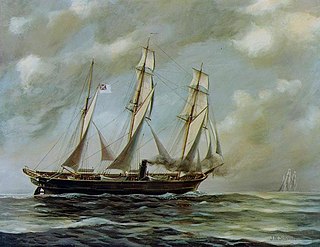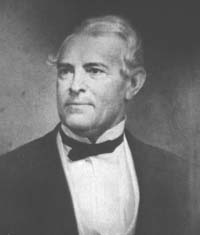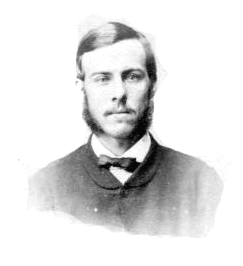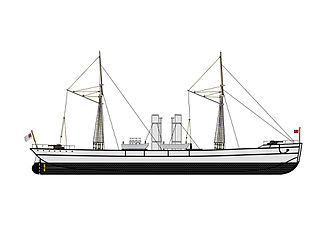
The Confederate States Navy (CSN) was the naval branch of the Confederate States Armed Forces, established by an act of the Confederate States Congress on February 21, 1861. It was responsible for Confederate naval operations during the American Civil War against the United States's Union Navy.

Stephen Russell Mallory was a Democratic senator from Florida from 1851 to the secession of his home state and the outbreak of the American Civil War. For much of that period, he was chairman of the Committee on Naval Affairs. It was a time of rapid naval reform, and he insisted that the ships of the US Navy should be as capable as those of Britain and France, the foremost navies in the world at that time. He also wrote a bill and guided it through Congress to provide for compulsory retirement of officers who did not meet the standards of the profession.

CSS Alabama was a screw sloop-of-war built in 1862 for the Confederate States Navy. It was built in Birkenhead on the River Mersey opposite Liverpool, England by John Laird Sons and Company. Alabama served as a successful commerce raider, attacking Union merchant and naval ships over the course of her two-year career. She was sunk in June 1864 by USS Kearsarge at the Battle of Cherbourg outside the port of Cherbourg, France.

Atlanta was a casemate ironclad that served in the Confederate and Union Navies during the American Civil War. She was converted from a British-built blockade runner named Fingal by the Confederacy after she made one run to Savannah, Georgia. After several failed attempts to attack Union blockaders, the ship was captured by two Union monitors in 1863 when she ran aground. Atlanta was floated off, repaired, and rearmed, serving in the Union Navy for the rest of the war. She spent most of her time deployed on the James River supporting Union forces there. The ship was decommissioned in 1865 and placed in reserve. Several years after the end of the war, Atlanta was sold to Haiti, but was lost at sea in December 1869 on her delivery voyage.

CSS Shenandoah, formerly Sea King and later El Majidi, was an iron-framed, teak-planked, full-rigged sailing ship with auxiliary steam power chiefly known for her actions under Lieutenant Commander James Waddell as part of the Confederate States Navy during the American Civil War.

CSS Florida was a sloop-of-war in the service of the Confederate States Navy. She served as a commerce raider during the American Civil War before being sunk in 1864.

CSSOwl was a blockade runner in the Confederate States Navy during the American Civil War. It was built by Jones Quiggen, a ship builder in Liverpool, England and launched on June 21, 1864.

CSSGeorgia was a screw steamer of the Confederate States Navy, acquired in 1863, and captured by the Union Navy in 1864.

CSS Sumter, converted from the 1859-built merchant steamer Habana, was the first steam cruiser of the Confederate States Navy during the American Civil War. She operated as a commerce raider in the Caribbean and in the Atlantic Ocean against Union merchant shipping between July and December 1861, taking eighteen prizes, but was trapped in Gibraltar by Union Navy warships. Decommissioned, she was sold in 1862 to the British office of a Confederate merchant and renamed Gibraltar, successfully running the Union blockade in 1863 and surviving the war.

George Alfred Trenholm was a South Carolina businessman, financier, politician, and slaveholding planter who owned several plantations and strongly supported the Confederate States of America. He was appointed as its Secretary of the Treasury during the final year of the American Civil War.

PSLelia was a steamship built in 1864, during the American Civil War for use as a blockade runner for the Confederate States of America. She sank in Liverpool Bay in 1865 in an incident that caused 46 fatalities.

James Dunwoody Bulloch was the Confederacy's chief foreign agent in Great Britain during the American Civil War. Based in Liverpool, he operated blockade runners and commerce raiders that provided the Confederacy with its only source of hard currency. Bulloch arranged for the purchase by British merchants of Confederate cotton, as well as the dispatch of armaments and other war supplies to the South. He also oversaw the construction and purchase of several ships designed at ruining Northern shipping during the Civil War, including CSS Florida, CSS Alabama, CSS Stonewall, and CSS Shenandoah. Due to him being a Confederate secret agent, Bulloch was not included in the general amnesty that came after the Civil War and therefore decided to stay in Liverpool, becoming the director of the Liverpool Nautical College and the Orphan Boys Asylum.
The Confederate Secret Service refers to any of a number of official and semi-official secret service organizations and operations conducted by the Confederate States of America during the American Civil War. Some of the organizations were under the direction of the Confederate government, others operated independently with government approval, while still others were either completely independent of the government or operated with only its tacit acknowledgment.

Irvine Stephens Bulloch was an officer in the Confederate Navy and the youngest officer on the famed warship CSS Alabama. He fired its last shot before it was sunk off the coast of France at the end of the American Civil War. He was a half-brother of James Dunwoody Bulloch, who served as a foreign agent in Great Britain on behalf of the Confederacy, in part to arrange blockade runners.

The CSS Tallahassee was a twin-screw steamer and cruiser in the Confederate States Navy, purchased in 1864, and used for commerce raiding off the Atlantic coast. She later operated under the names CSS Olustee and CSS Chameleon.

USS Vanderbilt was a heavy (3,360-ton) passenger steamship obtained by the Union Navy during the second year of the American Civil War and utilized as a cruiser.

USS Bermuda was a large steamer captured by the Union Navy during the American Civil War. She was used by the Union Navy as a cargo and general transport ship in support of the Union Navy blockade of Confederate waterways, primarily in Florida and the Gulf of Mexico. However, despite being a valuable cargo ship, she proved very adept at capturing blockade runners as her record proves.
The first USS Adirondack was a large and powerful screw-assisted sloop of war with heavy guns, contracted by the Union Navy early in the American Civil War. She was intended for use by the Union Navy as a warship in support of the Union Navy blockade of Confederate waterways. Her career with the Navy proved to be short, yet active and historically important. USS Adirondack was one of four sister ships which included the Housatonic, Ossipee and Juniata.

Throughout the American Civil War, blockade runners were seagoing steam ships that were used to get through the Union blockade that extended some 3,500 miles (5,600 km) along the Atlantic and Gulf of Mexico coastlines and the lower Mississippi River. The Confederate states were largely without industrial capability and could not provide the quantity of arms and other supplies needed to fight against the industrial North. To meet this need blockade runners were built in Scotland and England and were used to import the guns, ordnance and other supplies that the Confederacy desperately needed, in exchange for cotton that the British textile industry needed greatly. To penetrate the blockade, these relatively lightweight shallow draft ships, mostly built in British shipyards and specially designed for speed, but not suited for transporting large quantities of cotton, had to cruise undetected, usually at night, through the Union blockade. The typical blockade runners were privately owned vessels often operating with a letter of marque issued by the Confederate States of America. If spotted, the blockade runners would attempt to outmaneuver or simply outrun any Union ships on blockade patrol, often successfully.

Charles Kuhn Prioleau (1827–1887) was an American cotton merchant who became the senior partner of Fraser, Trenholm & Company in Liverpool, England, a firm that functioned as the European banker of the Confederacy and was its major supplier for arms and military ware during the American Civil War. As a firm that frequently acted as the European banker of the Confederacy it often extended it credit, and was sometimes referred to as "the Confederate Embassy in England".


















